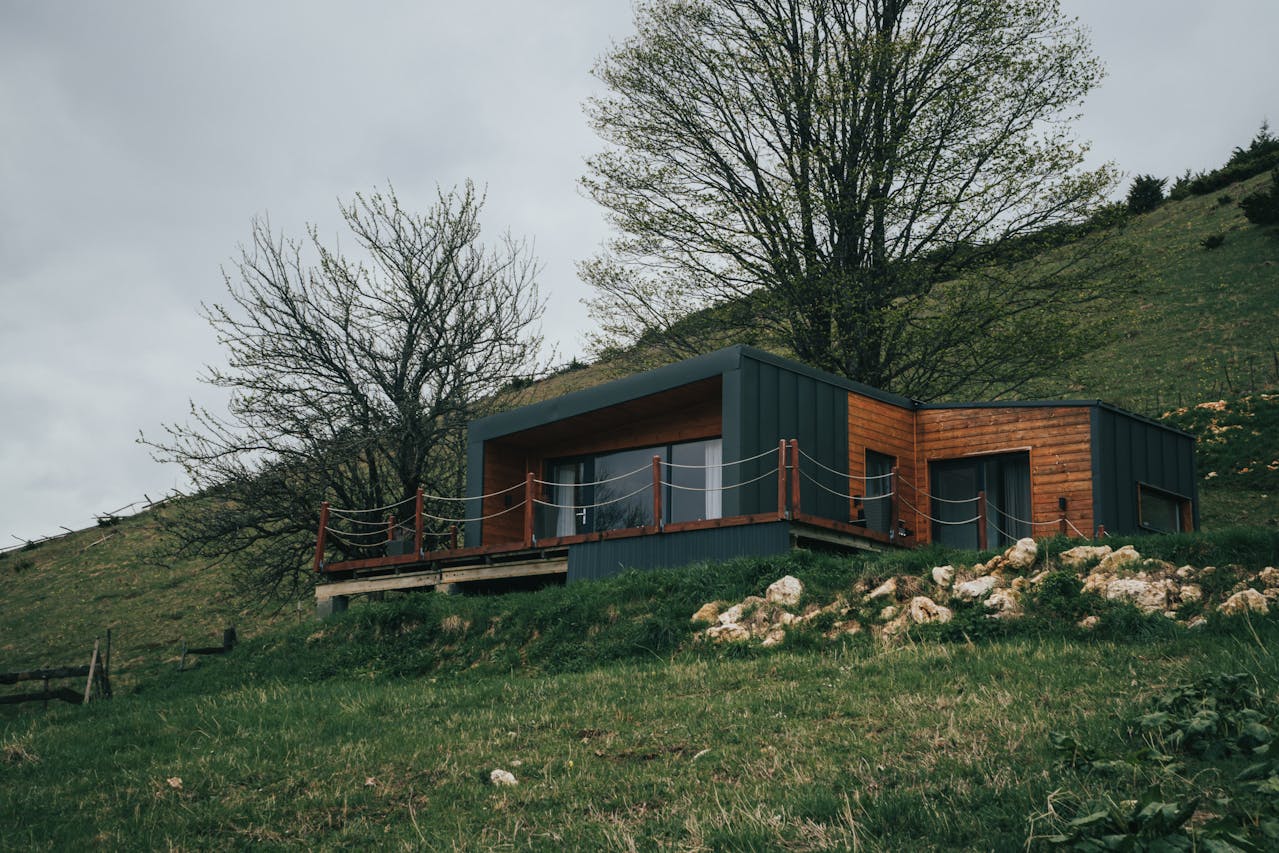
Sustainable Living in Woodland Cabins
Living sustainably in a wood cabin provides a unique opportunity to reconnect with nature while embracing environmentally beneficial habits. The following are a few significant benefits that demonstrate why this lifestyle is becoming increasingly appealing to many people.
Eco-friendliness and Reduced Carbon Footprint
Choosing a wood cabin as a habitation considerably reduces one’s carbon footprint. These cabins frequently integrate well with their surroundings, reducing the impact on the local ecosystem. Natural materials used in construction, such as wood, emit less carbon dioxide during manufacturing and shipping than typical building materials.
Improved Energy Efficiency
Woodland cottages are often designed with energy efficiency in mind. Proper insulation and intelligent window placement can maintain pleasant interior temperatures, reducing their dependency on artificial heating and cooling systems. This results in reduced energy use, which contributes to more sustainable living.
Sustainable Building Materials
Using sustainable building materials is essential for eco-friendly cabin construction. Key features include:
Reclaimed and Renewable Wood
Reclaimed wood sourced from ancient barns, furniture, or other structures adds character while reducing trash. Renewable wood sourced from carefully managed forests ensures a steady supply that does not destroy natural resources.
Low-VOC Paints and Finishes
Many paints and finishes include volatile organic compounds (VOCs), contributing to indoor air pollution. Opting for low-VOC options improves indoor air quality and demonstrates a commitment to sustainability.
Advanced Design Techniques
Modern design approaches improve the sustainability of log homes by making smart building decisions.
Insulation Methods for Log Cabins
Log cabins can be supplied with various insulation alternatives, including cellulose, sheep wool, and spray foam, to improve thermal efficiency and reduce energy use.
Passive Solar Design Principles
Using passive solar design strategies, such as strategically placed windows to maximize natural light and heat, reduces artificial lighting and heating needs. This technique not only reduces energy expenses but also brings the beauty of nature into daily life.
Renewable Energy Integration
Using renewable energy sources is an essential component of sustainable cabin living.
Implementing Solar Panels
Installing solar panels can provide a steady supply of clean energy for lighting, appliances, and heating systems. This reduces reliance on fossil fuels and may lead to lower long-term energy prices.
Rainwater Harvesting Systems
Collecting rainwater for irrigation, laundry, and even drinking (with adequate filtering) helps to conserve resources and promotes sustainability. It reduces the strain on municipal water systems and provides a reliable water source.
Connection to Nature
Living in a woodland cabin strengthens your connection to nature, providing benefits that are difficult to imitate in metropolitan settings.
Benefits of Living Amidst Greenery
Being surrounded by nature has a relaxing impact, leading to better mental health and less stress. The beauty of forests and wildlife can help to improve general well-being.
Enhanced Outdoor Experiences
Woodland cabins offer easy access to outdoor activities, including hiking, bird watching, and exploring natural landscapes. This way of life promotes physical activity and a greater respect for nature.
Indoor Environment Quality
A well-built log cabin can offer a healthier indoor atmosphere with appropriate design choices.
Natural Ventilation in Log Cabins
Designing cabins with natural ventilation allows fresh air to flow while eliminating stale air. This helps to maintain a continuously comfortable indoor atmosphere without relying heavily on heating and cooling equipment.
Reduced Allergens and Pollutants
Natural materials commonly utilized in log cabin construction, combined with low-VOC coatings, reduce allergies and indoor pollutants, providing better living environments.
Durability of Log Cabin Structures
Log cabins are noted for their long-lasting quality when built and maintained appropriately.
Longevity and Maintenance of Log Cabins
Log cabins are inherently durable, with many lasting for decades. Regular maintenance, such as treating the wood to prevent rot and vermin, can significantly increase its life.
Weather Resistance and Robustness
The strong structure of log cabins makes them resistant to extreme weather, providing homeowners with protection and peace of mind in various environments.
Practical Considerations for Building Cabins
A sustainable cabin lifestyle demands careful planning and implementation.
Site Selection and Preparation
Choosing the appropriate location is critical for reducing environmental effects. Considerations include proximity to existing infrastructure, conservation of natural resources, and respect for wildlife habitats.
Permits and Regulations
Understanding zoning rules and securing any necessary licenses is critical before beginning construction. Compliance with local rules guarantees that the cabin meets both safety and environmental requirements.
Tips for Maintaining Sustainable Cabins
Regular upkeep for longevity
Maintaining a wood cabin is critical for extending its life and reducing environmental impact. Regular inspections of the structure, including checking for signs of wear and tear, aid in detecting possible problems before they become serious.
This includes inspecting the roof for leaks, evaluating the logs’ integrity, and assuring the foundation’s stability. Keeping gutters clean and debris-free lets rainwater drain correctly, reducing moisture-related damage.
Create a routine maintenance regimen, focusing on seasonal duties like adding protective dyes or sealing procedures to increase the durability of natural wood.
Sustainable Maintenance Practices
Sustainable maintenance measures benefit not only the longevity of your cabin but also the surrounding ecosystem. For example, use eco-friendly cleaning products to reduce dangerous chemicals in the environment.
Incorporate methods like composting organic waste from cabin life to benefit the surrounding soil rather than contributing to landfill growth.
Using locally sourced materials for repairs and restorations may lower your carbon footprint while also helping local businesses. When replacing appliances, consider incorporating energy-efficient options to promote a harmonious relationship with nature.
Final Thoughts
Living sustainably in a wood cabin provides a distinct lifestyle that promotes environmental harmony and human well-being. Forest living’s natural beauty and calm create a healing backdrop, encouraging a stronger connection to nature.
Cabin residents can enjoy their peaceful retreat while helping the environment by applying sustainable methods, from construction to regular upkeep.